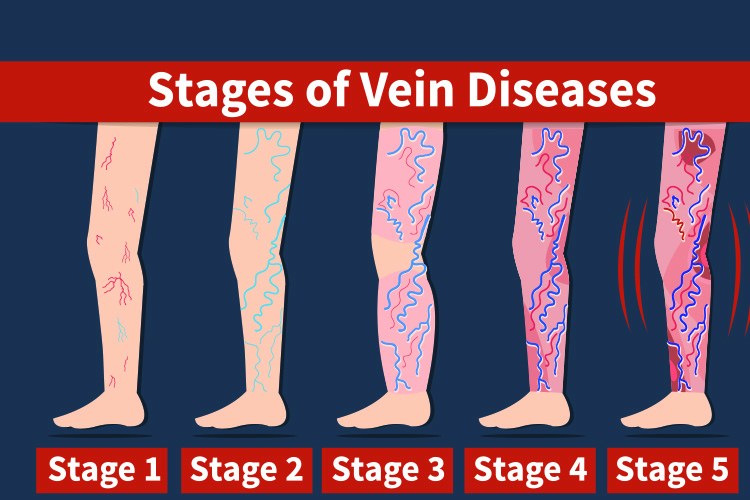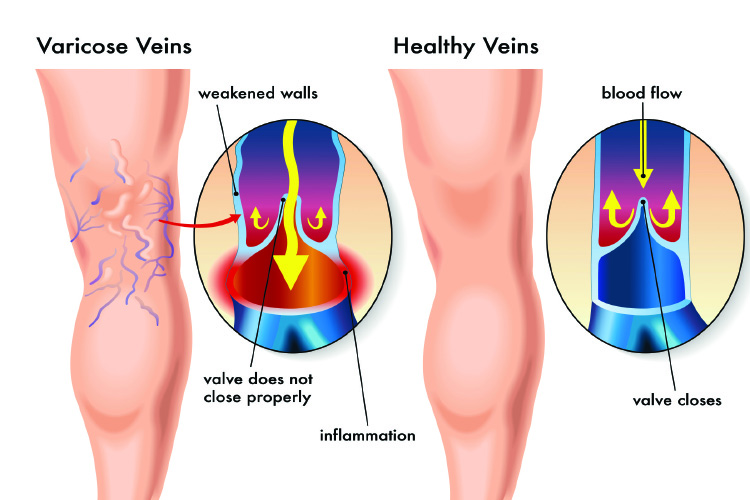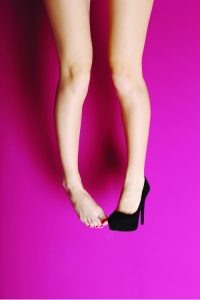Your feet are perhaps the only part of your body that is continuously on display and at function. It is therefore very easy for them to fall prone to all kinds of illnesses. With age, their functions increase and they are subject to more exposure. Hence, it is quite common for women to develop skin conditions including Spider Veins and Varicose Veins that can potentially become serious conditions if not looked into early.
Table of Contents
The Difference: Varicose Veins and Spider Veins
Varicose veins are large, raised, swollen blood vessels that twist and turn. They usually develop in the legs and can be seen through the skin. Spider veins are smaller, red, purple, and blue vessels that also twist and turn. Spider veins are easily visible through the skin, as well.
Spider veins are like varicose veins, but smaller and closer to the surface of the skin. They are often red or blue, and can look like tree branches or spider webs. They are mostly found on a person’s legs or face. They may cover a small or large area.
What are the causes that lead to Spider Veins and Varicose Veins?
The prime reason of the occurrence of Spider Veins and Varicose Veins is structural abnormality of blood vessels. The one-way valves which are used by veins to carry blood from different parts of the body to the heart can become flawed for a number of reasons causing the backflow of the blood in the veins. This backflow subsequently increases the collection of blood and pressure in the vein and weakens the walls of the blood vessels. The dilation of the affected blood vessels then leads to the conditions known as Spider Veins and Varicose Veins.
What factors trigger these conditions?
There are a variety of factors that determine the occurrence of Spider Veins and Varicose Veins in adults. Health conditions or behaviours like prolonged sitting/standing, obesity, birth control pills, advanced age, pregnancy, injury, hormone therapy, history of blood clots and prior vein injury contribute to the occurrence of Spider and Varicose Veins. Family history is also an important factor.
While Spider Veins and Varicose Veins, in the most typical of their occurrence, do not cause any signs or symptoms other than their aesthetic appearance on the body, there may be instances where some individuals may experience some troubling symptoms in the case of Varicose Veins. These symptoms include swelling, aching, throbbing, burning, heaviness, cramping, itching or tingling of the legs and/or feet. These symptoms tend to get worse after prolonged action of standing or sitting.
There are also instances, though very rare, where these skin conditions cause serious skin complications such as skin ulcers.
What can you do to prevent Spider Veins and Varicose Veins?
Not all varicose and spider veins can be prevented. But, there are some steps you can take to reduce your chances of getting new varicose and spider veins. These same things can help ease discomfort from the ones you already have:
- Wear sunscreen to protect your skin from the sun and to limit spider veins on the face.
- Exercise regularly to improve your leg strength, circulation, and vein strength. Focus on exercises that work your legs, such as walking or running.
- Control your weight to avoid placing too much pressure on your legs.
- Don’t cross your legs for long times when sitting. It’s possible to injure your legs that way, and even a minor injury can increase the risk of varicose veins.
- Elevate your legs when resting as much as possible.
- Don’t stand or sit for long periods of time. If you must stand for a long time, shift your weight from one leg to the other every few minutes. If you must sit for long periods of time, stand up and move around or take a short walk every 30 minutes.
- Wear elastic support stockings and avoid tight clothing that constricts your waist, groin, or legs.
- Avoid wearing high heels for long periods of time. Lower-heeled shoes can help tone your calf muscles to help blood move through your veins.
- Eat a low-salt diet rich in high-fibre foods. Eating fibre reduces the chances of constipation, which can contribute to varicose veins. High-fibre foods include fresh fruits and vegetables and whole grains, like bran. Eating less salt can help with the swelling that comes with varicose veins.
In addition to lifestyle changes, you can also adopt a number of home remedies to lessen the extremities of Spider and Varicose Veins. Some effective home remedies include:
Apple Cider Vinegar:
This is perhaps an ingredient which is effective in healing most of the health conditions in the human body. According to a study done in 2016, the external application of apple cider vinegar on varicose veins augments the healing procedure.
All you have to do is soak a piece of cloth in apple cider vinegar and wrap it around the area(s) of your body which are affected by Spider and Varicose Veins. Let the cloth rest for 15 to 20 minutes. Do this twice a day until the veins are hardly visible. Apple Cider Vinegar can also be consumed internally if you wish to. Mix 1 spoon of apple cider vinegar with warm water and organic honey and consume before meals.
Lemon essential oil:
Just like oil is used to improve the circulation of blood on the scalp, it can be used to improve blood circulation in the areas affected by spider and varicose veins. Mix 3 to 4 drops of lemon essential oil with any oil that you prefer (coconut, almond etc.) and apply swiftly on the affected area. Massage gently about twice or thrice daily. You can repeat the same process with Mustard Oil as well.
Oranges and Guava:
Oranges and Guavas are two fruits which considerably contribute to healing Spider and Varicose Veins. Rich in Vitamin C, the consumption of these fruits helps in regulating blood flow and preventing discolouration.
Modern therapy to consider
Sclerotherapy:
This is perhaps the most effective treatment when it comes to treating Spider and Varicose Veins. The treatment consists of injection of a solution—made of salt, glycerin and fatty acids—into the defective vein. The solution causes the vein to collapse and allows the blood to flow back into the blood stream. This treatment is fairly similar to getting a shot just without any downtime. Some patients may experience bruising after the injection but they tend to disappear in 8 to 14 days.
Cryo-Sclerotherapy:
This is an absolutely painless version of sclerotherapy where instead of an injection a blast of cool air is incorporated to numb the skin.
Foam Sclerotherapy:
This is the last option in the sclerotherapy treatment where foam clings to the wall of the vein. This procedure is typically performed on larger veins and usually takes more time to cure the condition.




















